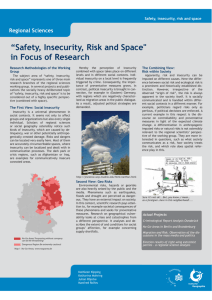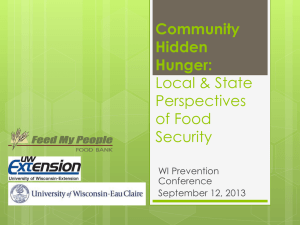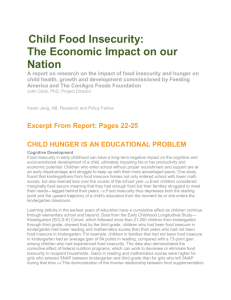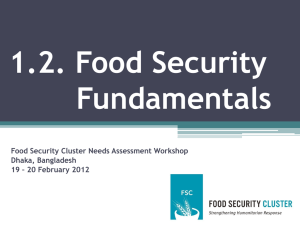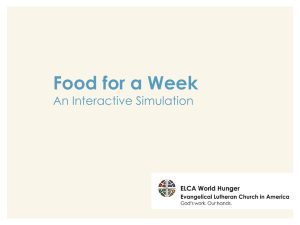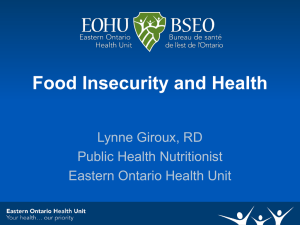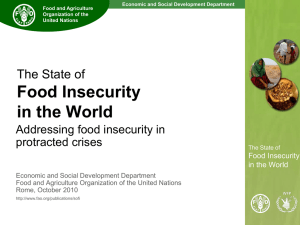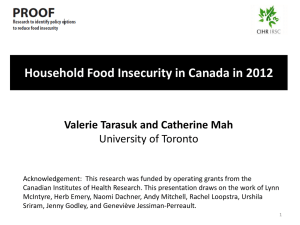Leah Anderson, Family Medicine, Bozeman
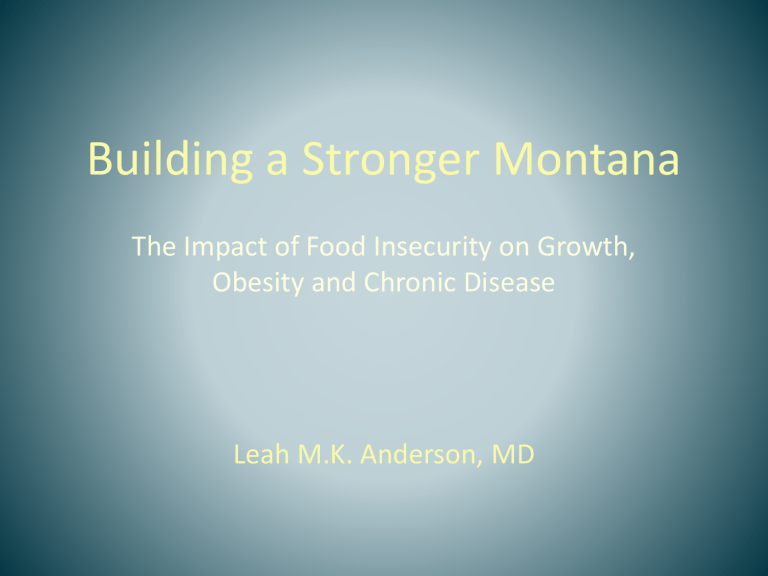
Building a Stronger Montana
The Impact of Food Insecurity on Growth,
Obesity and Chronic Disease
Leah M.K. Anderson, MD
Food insecurity in children
• Short-term health
• Chronic disease
• Mental health
• Obesity
Food insecure children are more likely to be in poor health
Food Insecurity and Health
Food Insecurity and Health
Food Insecurity and Health
Food insecure children are more likely to have chronic disease
Food Insecurity and Chronic Disease
• Associated with
• diabetes
• heart disease
• Children experiencing hunger are more likely to experience
• lower physical functioning
(Casey, 2005)
• more frequent stomachaches and headaches
(Alaimo,
2001)
Food Insecurity and Mental Disease
• Increased depression
• Increase anxiety
( Weinreb 2002)
• Increased suicidal tendencies
(Alaimo, 2002)
Food Insecurity and Mental Disease
Food insecure children are more likely to be overweight or obese
Food Insecurity and Obesity
• Study of 6,500 children
– food insecurity was positively associated with overweight and obesity in those 12 to 19 years of age.
( Townsend & Melgar-Quinonez, 2003)
• National sample of almost 7,000 children
– childhood food insecurity was associated with overweight.
(Casey
2005)
• A three-city study (Boston, San Antonio, and Chicago) of
1,011 adolescents
– maternal stress in combination with adolescent food insecurity significantly increased adolescent’s probability of being overweight or obese.
(Lohman, 2009)
Food Insecurity and Obesity
• National sample of 8,693 infants and toddlers
– indirect association between food insecurity and overweight that operated through parenting practices and infant feeding practices.
(Bronte-Tinkew, 2007)
• Among 2- 5-year-old girls – but not boys – in
Massachusetts participating in WIC
– food insecure homes had 47 percent higher odds of being obese compared to those from food secure homes.
(Metallinos-
Katsaras, 2009)
Food Insecurity and Obesity
• How does this occur?
– Limited resources
– Lack of access to healthy, affordable foods
– Fewer opportunities for physical activity
– Cycles of food deprivation and overeating
• Chronic deprivation leads to neuro-chemical changes that increase reward effect of food even when food later becomes plentiful
• Increased drive for energy-dense foods
– High levels of stress
• Stress hormones can further drive power of food reward
– Greater exposure to marketing of obesity-promoting products
– Limited access to health care
Conclusions
• Food insecurity has real effects on well-being of children and adults
• Children who are food insecure are more likely to experience chronic mental and physical health problems
• Food insecurity is bimodal – representing both underconsumption as well as mal-consumption
• Chronic stress of real (or perceived) food deprivation can alter power and nature of food-desire
References
1.
Cook, J. T., Frank, D. A., Berkowitz, C., Black, M. M., Casey, P. H., Cutts, D. B., ... & Nord, M. (2004). Food insecurity is associated with adverse health outcomes among human infants and toddlers. The Journal of nutrition, 134(6), 1432-1438.
2.
Casey, P. H., Szeto, K. L., Robbins, J. M., Stuff, J. E., Connell, C. , Gossett, J. M., & Simpson, P. M. (2005). Child healthrelated quality of life and household food security. Archives of Pediatrics and Adolescent Medicine, 159(1), 51-
56.
3.
Alaimo, K., Olson, C. M., Frongillo, E. A. Jr., & Briefel, R. R. (2001). Food insufficiency, family income, and health in U.S. preschool and school-aged children. American Journal of Public Health, 91(5), 781-786.
4.
Seligman, H. K., Bindman, A. B., Vittinghoff, E., Kanaya, A. M., & Kushel, M. B. (2007). Food insecurity is associated with diabetes mellitus: Results from the National Health Examination and Nutrition Examination Survey (NHANES)
1999
–2002. Journal of General Internal Medicine, 22(7), 1018-1023.
5.
Seligman, H. K., Laraia, B. A., & Kushel, M. B. (2010). Food insecurity is associated with chronic disease among lowincome NHANES participants. Journal of Nutrition, 140(2), 304-310.
6.
Siefert, K., Heflin, C. M., Corcoran, M. E., & Williams, D. R. (2004). Food insufficiency and physical and mental health in a longitudinal survey of welfare recipients. Journal of Health and Social Behavior, 45(2), 171-186.
7.
Weinreb, L., Wehler, C., Perloff, J., Scott, R., Hosmer, D., Sagor, L., & Gundersen, C. (2002). Hunger: its impact on children's health and mental health. Pediatrics, 110, e41
8.
Alaimo, K., Olson, C. M., & Frongillo, E. A. (2002). Family food insufficiency, but not low family income, is positively associated with dysthymia and suicide symptoms in adolescents. Journal of Nutrition, 132, 719−725.
9.
Townsend, M. & Melgar-Quinonez, H. (2003). Hunger, food insecurity, and child obesity. Food Assistance and Nutrition Research
Report, 38. Washington, DC: U.S. Department of Agriculture, Economic Research Service.
10. Lohman, B. J., Stewart, S., Gundersen, C., Garasky, S., & Eisenmann, J. C. (2009). Adolescent overweight and obesity: links to food insecurity and individual, maternal, and family stressors. Journal of Adolescent Health, 45(3), 230-237.
11.
Bronte-Tinkew, J., Zaslow, M., Capps, R., Horowitz, A., & McNamara, M. (2007). Food insecurity works through depression, parenting, and infant feeding to influence overweight and health in toddlers. Journal of Nutrition, 137(9), 2160-2165.
12.
Metallinos-Katsaras, E., Sherry, B., & Kallio, J. (2009). Food insecurity is associated with overweight in children younger than 5 years of age. Journal of the American Dietetic Association, 109(10), 1790-1794
